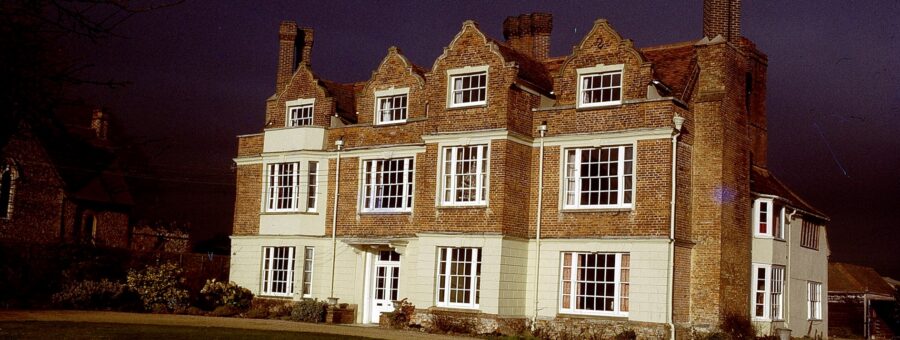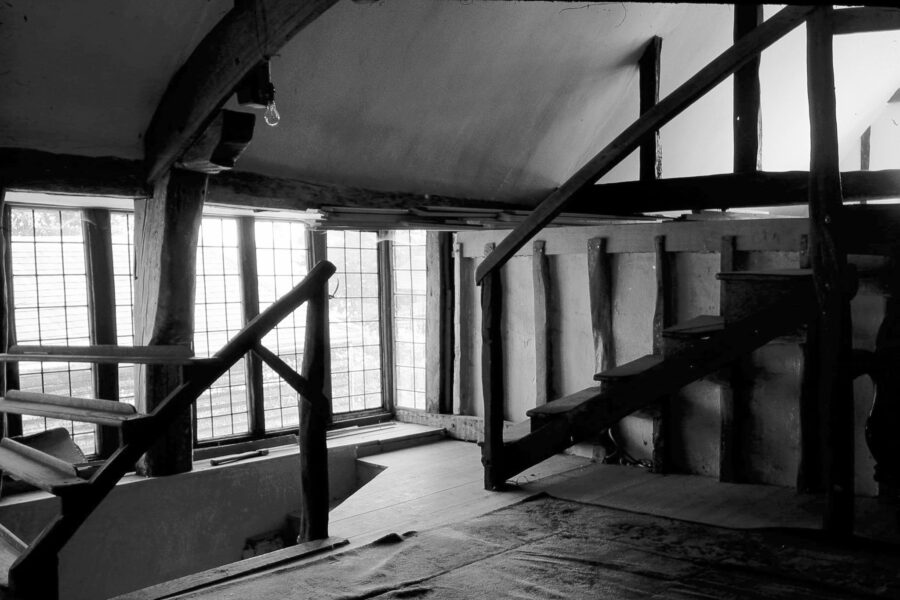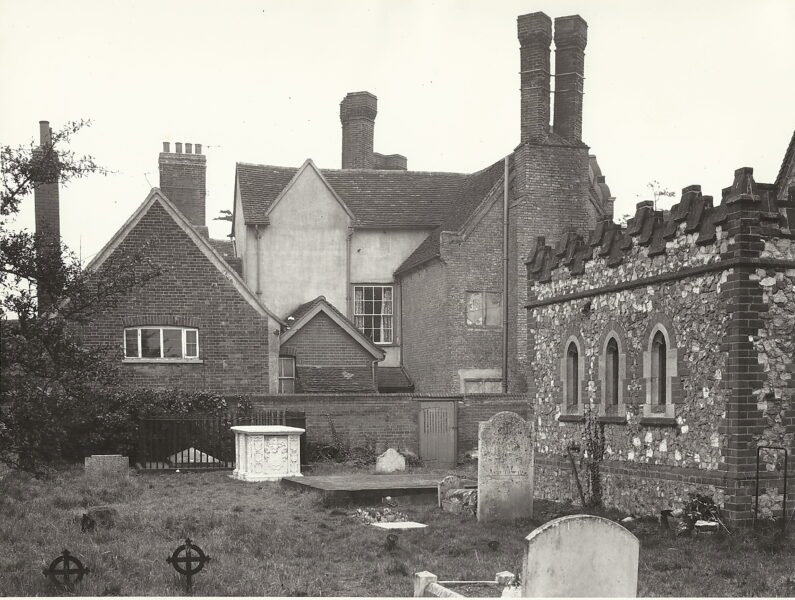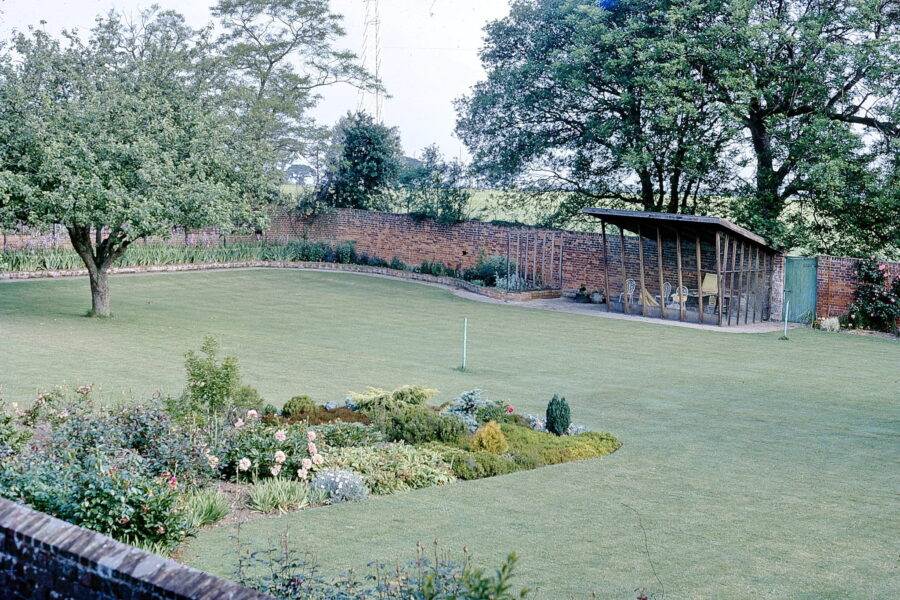Growing Up with Haunted Houses

Shôn Ellerton, Feb 7, 2022
A trip down memory lane of staying in a creepy old, supposedly haunted, English mansion as a child.
Let me tell you, I’m a big fan of books and movies about ghosts, haunted houses and weird places that don’t seem to fit neatly into our known physical world. Forget the gory slasher and vampire stuff. Not interested at all. But movies featuring endless hotel corridors, cold spots, bulging walls, or old houses with alternate worlds accessible from behind hideous wallpaper. And of those books and short stories telling stories of the supernatural that would just lose its awesome scariness if portrayed on screen. Stories describing overgrown backyards which, should anyone dare to venture into it, will get lost forever in a sort of twisted alternate dimension. Or creepy sandbank islands with haunted trees in the middle of the sluggish Danube River. Or about houses with internal dimensions being vastly larger than the outside containing portals to hellish underworlds, often with spiral staircases of course. Love this stuff and, no doubt, some of my readers will know what these works are.
However, and frustratingly, I have yet to see a ghost or some sort of premonition. I can’t say they don’t exist, but I cannot prove their non-existence, much like an atheist cannot disprove the existence of God. I am, in general, sceptical of the supernatural which is why, if given the opportunity, I would avail myself to spending a night in the most haunted of places. Alas, many of these places are generally off-limits to curious adventurers or just too difficult to get access to. Abandoned hospitals and lunatic asylums, like the one on Poveglia Island near Venice. The Japanese ‘suicide’ forest called Aokigahara. The master bedroom in the Monte Cristo mansion in New South Wales. And many other scary places of ill repute.
However, in my childhood, I have many memories of spending many a night in a large old English mansion in Essex, supposedly haunted. It was in use by my grandfather, a man of sugar beet research fame. The company he worked for owned the mansion and had some of the ground floor rooms kitted out with laboratory apparatus. My grandparents were, essentially, the caretakers of the mansion.
My parents, at the time, did not live very far away making it a convenient place to drop off the children, being me and my sister, although it was probably usually me because my sister must have been, say, only one year old and I’m a few years older. I always looked forward to spending some time–and getting a little spoiled–by the grandparents, and no doubt my parents had some respite as well. As for the mansion, a Grade II listed building called Woodham Mortimer Hall, I was not quite as enthralled with the place when it was lights out and time for bed, but otherwise, it was a place of adventure and mystery. It was one of those houses in which one could find themselves in some removed wing or extension or happen to end up in some neglected room and be surrounded by near-silence or some other forlorn sound like that of a saddened caw of a crow from beyond the windowpane. Moreover, this could be happening when a full-out dinner and cocktail party took place the much more habitable second floor of the house. And, yes, there was a conveniently located old church and graveyard just next door just to add to the atmosphere.
It isn’t the largest of mansions, but it was certainly large enough to be one of those places where daily activity was kept to a few of its most popular rooms, the others being hardly used. It was a bit of a hotch-botch of various architectural styles tacked onto each other. The old 15th-century bit at the back against the newer 17th-century main structure with modern single-storey more relatively modern annexes running off the sides. The main structure is of three-floors with high ceilings and large rooms, although there was confusing mid-storey level in which the old met the new. It has a rectangular spiral staircase leading to the top floors. The entrance foyer is quite magnificent with ancient wood panelling and a large tessellated tiled floor which, at the time, was adorned with a centrally placed large heavy-set antique table laden with pots of dried flowers and bowls of apples and pears by my grandmother who, to the best of her ability, tried to make the otherwise cold and spartan room as inviting as possible. Suits of armour and swords crossed hanging off the walls wouldn’t have looked too far out of place, but alas, I had none of them there to play with. On the far side of the foyer, facing the main entrance was the old grandfather clock, an item which keeps ticking today in my present house. Reminding me of Poe’s House of Usher, it was the unfailing heartbeat of the house, the incessant ticking of the clock echoing down the darkened side-corridors into rooms I vaguely remember. To this day, I harbour strange dreams of unexplored or forgotten rooms in this house. I regret that no one bothered to take many photos inside the house.
Hanging off to the right of the entrance foyer was the laboratory, and to the left, a rather nice library and study complete with chaise-lounges, antique chairs, a desk, and a single bed. These rooms were spacious with large multi-paned windows and tall ceilings. The air was always a little musty; that smell of old woodwork combined with damp brick, old books, and ancient stone, mixed with old dried bowls of dead flowers and lavender. The ground floor was essentially unoccupied except for weekday work in the laboratory, although down the side corridors, there was an annex which was fitted out for a family whose father worked in the same company. The annex had rooms with modern normal proportions for family living being of a far more intimate and cosy nature; and easier to heat.
The second floor was where most of my grandparent’s living arrangements were confined. It had the kitchen, the living room, the dining room, and a large master bedroom if I correctly remember. The only two rooms in the entire house being warm and cosy during much of the year was the kitchen and the living room, the other rooms hardly being used except for sleeping or formal dining. The rest of the place was generally cold and held a sort of perpetual dampness in the air. When the occasion arose to spend a penny during the night, it was the usual customary procedure to shiver incessantly whilst navigating to the one bathroom located off the spiral staircase before dashing back to bed and diving back into layers and layers of sheets and blankets trying to get warm again.
My grandparents had the master bedroom on the second floor, a substantial room complete with one of those heavy ornate wooden beds with side curtains and canopies embroidered with Paisley-style exotic birds in a sort of bluish colour. Very old-fashioned. I had one of the three bedrooms on the top floor, and I was usually alone. It had lower ceilings, sloped to follow the contour of the house. It had all the trappings of a place ideally set for a ghost story. I remember my grandfather reading to me in bed to get me asleep, but almost without fail, I used to wake up in the dead of night. If it was to make an errand to the bathroom, this involved that expedition back down the staircase in the icy air, in the dark, prodding with sonar-like sense to anything familiar to guide me. As kind grandparents usually are, in those days, the idea of placing nightlights in darkened corridors, let alone, long dangerous staircases was generally unheard of. Except for the clock way at the bottom and any wind moaning through window cracks and creaky doors, it was always eerily silent.
But it was during the moments when I sat bolt upright in bed for no reason I can remember quite vividly. The moon with its pale blueish light casting its eminence through the window onto a crib on the opposite side of the room, possibly used when my sister came to stay as well, but I can’t quite remember. My bed was positioned in a sort of alcove with an overhung ceiling which provided some sense of ‘cosiness’ and sanctuary from unwanted shadows infesting the room that might spring to life, a common nightmare for most young children. Most would agree with me that sleeping in a bed slap-bang in the middle of a large room is creepy by design. In those moments of insecurity and sometimes, dread, I’d switch on the bedside lamp and try to read and then I’d half-fall asleep as various objects and furniture in the half-light, including an old-fashioned looking vacuum cleaner, started to move around on their own. I was convinced that the vacuum cleaner had nefarious designs planned for me and that it had wanted nothing better to do than to ambush me before I safely arrived at the top of the spiral staircase. Being brought up on a diet of Dr Who and Daleks, I felt somewhat secure that the staircase served as an impediment to that vacuum cleaner! Such is the imagination of children.
The room adjacent to me on the top floor was accessed through a lowish-height door with a little step-up just behind it. It was a long, peculiar, and narrow room with a double bed in it, sometimes used by my parents on the occasional visit. It was a perpetually sombre and dark place void of, for what I remember most, of colour. What’s particularly interesting about this room is that underneath the floorboards was rediscovered the Chamberlen forceps of obstetric fame during the 1800s. Another story about the room was that someone got murdered there but whether the story is true or not isn’t clear to me; however, be that as it may, it was a genuinely creepy place, as was the whole of the top floor. I eventually stopped sleeping up there and chose to sleep in the large ground-floor study and library, adjacent to the foyer and the soothing ticking grandfather clock. Never did I have a bad night since.
I have some affinity with those stories of children growing up in large and almost empty spaces like these. Everything is much bigger as a young child and unexplained; still is for many as they get older. Living in such places is an adventure at the best of times and there always seems to be some nook and cranny not yet explored. It felt like being part of the Famous Five. Great garden walls with a rear garden door that led to a copse of old oaks and a boggy field of mushrooms, and a little further out, a mysterious muddy pond that seemed to be always lingering in some kind of fog or mist. There were strange boarded up windows from the outside, but seemingly difficult to find which room to locate from the inside. There was an even an old priest hole and tunnel from the house to the adjacent church used when Catholics were persecuted and hunted down in olden times. Such adventure, but that was to end when my grandfather retired and had to move out. But the memory persists.
Although I don’t really believe in ghosts in the conventional sense, there was, most definitely, something peculiar and odd about some of the spaces in that house. Perhaps it is all psychosomatic or just something instilled through stories. For example, bad geometry, however slight, is uncannily detected by our perceived notion of what feels right or wrong; an antithesis to the ‘golden section’ or perfect design. Shirley Jackson, in her novel, The Haunting of Hill House, refers to a house in which no corner in the house was square, enough to set the nerves affray. And of course, those houses which no light can properly penetrate or seem eternally cold despite any attempts to heat them.
Later I was to learn there were such places like the Borley Rectory, a once notoriously haunted house not too far north in Suffolk apparently riddled with strange sightings such as writings on the wall, poltergeists and otherworldly sounds of organs playing and children laughing ethereally throughout the empty corridors. Sadly, the rectory was eventually burned down, but I was mesmerised with its stories. Later research revealed that many of these ‘hauntings’ at Borley Rectory were hoaxes played out by the more recent of the owners to entice psychic researchers to stay for a fee. However, not all of the anomalies and weird events that took place at the rectory have ever been explained.
I’ve asked the question to many. Would you stay overnight alone in an infamously haunted house or some other place of ill repute? Not surprisingly, many would not, but fear is the mind-killer, to quote a line out of Dune. And to overcome that fear, one must accept the strange, unwelcoming and the disconcerting with an open mind and break the shackles of conventional thought and overcome those beliefs instilled by others.
Haunted houses, for many of us, are fascinating places. There is no shortage of them in folklore and works of fiction and whether one believes in them or not, they often have very interesting histories. Sometimes the histories are too horrible to comprehend such as the infamous house of Fred West in Gloucester, in which were found a dozen or so victims who were murdered and buried on the premises. The house was later removed and replaced with some trees and a path. Although not being superstitious, I would never live in a house that had such a recently horrible history. No doubt, most of us would feel likewise. As for staying the night in a place of evil, ill repute, or just, very haunted, I’d be game, but I’d better be armed with a bottle of Scotch!
Old section of house facing the rear garden
Left side of house taken from adjacent graveyard
Walled garden with garden gate to the mysterious pond





